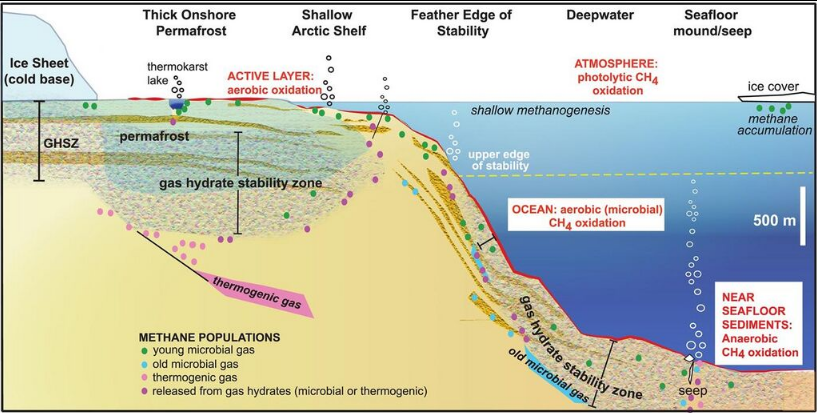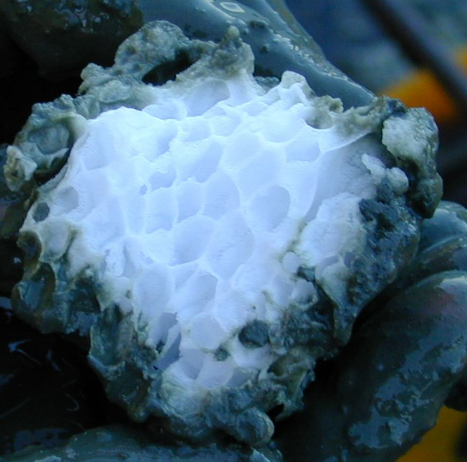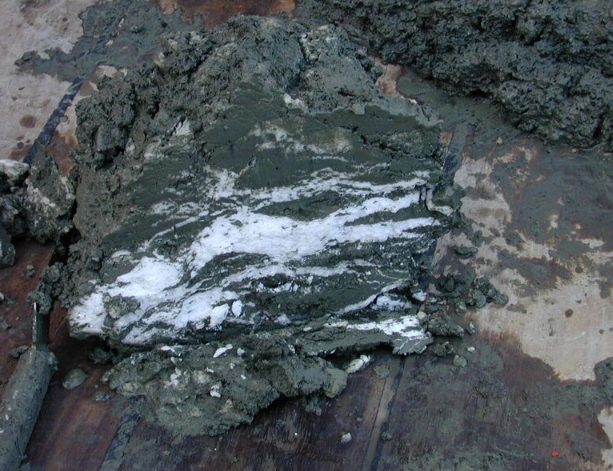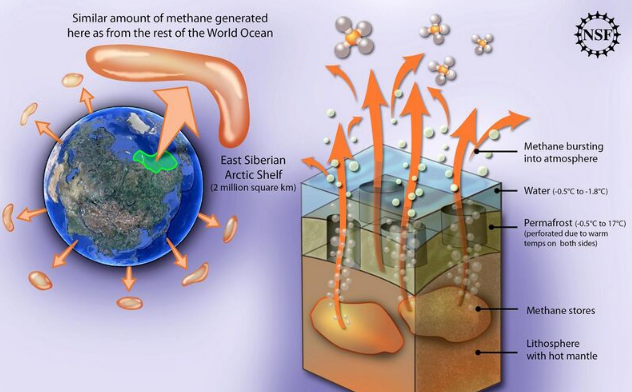
| Version | Summary | Created by | Modification | Content Size | Created at | Operation |
|---|---|---|---|---|---|---|
| 1 | Jason Zhu | -- | 2489 | 2022-10-18 01:32:40 |
Video Upload Options
The clathrate gun hypothesis refers to a proposed explanation for the periods of rapid warming during the Quaternary. The idea is that changes in fluxes in upper intermediate waters in the ocean caused temperature fluctuations that alternately accumulated and occasionally released methane clathrate on upper continental slopes, these events would have caused the Bond Cycles and individual interstadial events, such as the Dansgaard–Oeschger interstadials. The hypothesis was supported for the Bølling-Allerød and Preboreal period, but not for Dansgaard–Oeschger interstadials, although there are still debates on the topic.
1. General

Studies published in 2000 attributed the hypothesis to be responsible for warming events in and at the end of the Last Glacial Maximum,[2] but the distinct deuterium/hydrogen (D/H) isotope ratio indicates the methane was released by wetlands instead.[3][4] Although periods of increased atmospheric methane matches periods of continental-slope failure.[5][6]
At one point there seemed to be stronger evidence that runaway methane clathrate breakdown may have caused drastic alteration of the ocean environment (such as ocean acidification and ocean stratification) and of the atmosphere over timescales of tens of thousands of years during the Paleocene–Eocene Thermal Maximum 56 million years ago, and most notably the Permian–Triassic extinction event, when up to 96% of all marine species became extinct, 252 million years ago.[7][8] However, the pattern of isotope shifts expected to result from a massive release of methane does not match the patterns seen there. First, the isotope shift is too large for this hypothesis, as it would require five times as much methane as is postulated for the PETM,[9][10] and then, it would have to be reburied at an unrealistically high rate to account for the rapid increases in the 13C/12C ratio throughout the early Triassic before it was released again several times.[9] Yet, it is still argued that a potential positive feedback mechanism from clathrate dissociation would amplify future global warming. However, past hydrate dissociation at Svalbard eight thousand years ago has been attributed to isostatic rebound (continental uplift following deglaciation).[11]
The SWIPA 2017 report notes, "Arctic sources and sinks of greenhouse gases are still hampered by data and knowledge gaps."[12]
1.1. Possible Release Events
Two events possibly linked to methane excursions are the Permian–Triassic extinction event and the Paleocene–Eocene Thermal Maximum (PETM). Equatorial permafrost methane clathrate may have had a role in the sudden warm-up of "Snowball Earth", 630 million years ago.[13] However, warming at the end of the last ice age is not thought to be due to methane release. A similar event is the methane hydrate releases, following ice-sheet retreat during the last glacial period, around 12,000 years ago, in response to the Bølling-Allerød warming.[14][15]
2. Mechanism


Methane clathrate, also known commonly as methane hydrate, is a form of water ice that contains a large amount of methane within its crystal structure. Potentially large deposits of methane clathrate have been found under sediments on the ocean floors of the Earth, although the estimates of total resource size given by various experts differ by many orders of magnitude, leaving doubt as to the size of methane clathrate deposits (particularly in the viability of extracting them as a fuel resource). Indeed, cores of greater than 10 centimeters' contiguous depth had only been found in three sites as of 2000, and some resource reserve size estimates for specific deposits/locations have been based primarily on seismology.[16][17]
The sudden release of large amounts of natural gas from methane clathrate deposits in runaway climate change could be a cause of past, future, and present climate changes. The release of this trapped methane is a potential major outcome of a rise in temperature; some have suggested that this was a main factor in the planet warming 6 °C, which happened during the end-Permian extinction,[18] as methane is much more powerful as a greenhouse gas than carbon dioxide. Despite its atmospheric lifetime of around 12 years, it has a global warming potential of 72 over 20 years, 25 over 100 years, and 33 when accounted for aerosol interactions.[19] The theory also predicts this will greatly affect available oxygen and hydroxyl radical content of the atmosphere.
2.1. Subsea Permafrost
Subsea permafrost occurs beneath the seabed and exists in the continental shelves of the polar regions.[20] This source of methane is different from methane clathrates, but contributes to the overall outcome and feedbacks.
From sonar measurements in recent years researchers quantified the density of bubbles emanating from subsea permafrost into the ocean (a process called ebullition), and found that 100–630 mg methane per square meter is emitted daily along the East Siberian Shelf, into the water column. They also found that during storms, when wind accelerates air-sea gas exchange, methane levels in the water column drop dramatically. Observations suggest that methane release from seabed permafrost will progress slowly, rather than abruptly. However, Arctic cyclones, fueled by global warming, and further accumulation of greenhouse gases in the atmosphere could contribute to more rapid methane release from this source.[21]
2.2. Metastable Methane Clathrates
Another kind of exception is in clathrates associated with the Arctic ocean, where clathrates can exist in shallower water stabilized by lower temperatures rather than higher pressures; these may potentially be marginally stable much closer to the surface of the sea-bed, stabilized by a frozen 'lid' of permafrost preventing methane escape.
The so-called self-preservation phenomenon has been studied by Russian geologists starting in the late 1980s.[22] This metastable clathrate state can be a basis for release events of methane excursions, such as during the interval of the Last Glacial Maximum.[23] A study from 2010 concluded with the possibility for a trigger of abrupt climate warming based on metastable methane clathrates in the East Siberian Arctic Shelf (ESAS) region.[24]
2.3. Ocean Anoxia
In the past, euxinic (i.e. sulfidic) and anoxic events have occurred either over relatively short time scales (decades to centuries) due to a disrupting event such as a meteor impact or over tens of thousands to a few million years due to global changes in the Earth's climate. Both scenarios can result in the large scale release of methane and other greenhouse gases from the ocean into the atmosphere. It is postulated such a release could occur in a quick, explosive event due to the complex interplay of buoyancy forces and exsolution of dissolved gases in the ocean. Initially, the increased amounts of smoke and dust in the atmosphere would cause a relatively short period of stratospheric cooling but this would quickly be overtaken by the effects of global warming.[25]
3. Current Outlook
Most deposits of methane clathrate are in sediments too deep to respond rapidly, and modelling by Archer (2007) suggests the methane forcing should remain a minor component of the overall greenhouse effect.[26] Clathrate deposits destabilize from the deepest part of their stability zone, which is typically hundreds of metres below the seabed. A sustained increase in sea temperature will warm its way through the sediment eventually, and cause the shallowest, most marginal clathrate to start to break down; but it will typically take on the order of a thousand years or more for the temperature signal to get through.[26] However, there is also a possibility for the formation of gas migration pathways within fault zones in the East Siberian Arctic Shelf, through the process of talik formation, or pingo-like features.[27][28][29]
According to data released by the EPA, atmospheric methane (CH4) concentrations in parts per billion (ppb) remained between 400–800ppb in the years 600,000 BC to 1900 AD, and since 1900 AD have risen to levels between 1600–1800ppb.[30] Global averaged monthly mean atmospheric methane is currently at ~1860 ppb CH4, increases between 8.8 ± 2.6 through 2017 compare to an average annual increase of 5.7 ± 1.1 ppb between 2007 and 2013.[31]
A USGS metastudy in 2017 by the USGS Gas Hydrates Project concluded:[1][32]
Our review is the culmination of nearly a decade of original research by the USGS, my coauthor Professor John Kessler at the University of Rochester, and many other groups in the community," said USGS geophysicist Carolyn Ruppel, who is the paper’s lead author and oversees the USGS Gas Hydrates Project. "After so many years spent determining where gas hydrates are breaking down and measuring methane flux at the sea-air interface, we suggest that conclusive evidence for release of hydrate-related methane to the atmosphere is lacking.
3.1. Arctic Ocean

Research carried out in 2008 in the Siberian Arctic showed millions of tons of methane being released, apparently through perforations in the seabed permafrost,[29] with concentrations in some regions reaching up to 100 times normal levels.[33][34] The excess methane has been detected in localized hotspots in the outfall of the Lena River and the border between the Laptev Sea and the East Siberian Sea. At the time, some of the melting was thought to be the result of geological heating, but more thawing was believed to be due to the greatly increased volumes of meltwater being discharged from the Siberian rivers flowing north.[35] The current methane release had previously been estimated at 0.5 megatonnes per year.[36] Shakhova et al. (2008) estimate that not less than 1,400 gigatonnes of carbon is presently locked up as methane and methane hydrates under the Arctic submarine permafrost, and 5–10% of that area is subject to puncturing by open taliks. They conclude that "release of up to 50 gigatonnes of predicted amount of hydrate storage [is] highly possible for abrupt release at any time". That would increase the methane content of the planet's atmosphere by a factor of twelve,[37][38] equivalent in greenhouse effect to a doubling in the current level of CO
2.
This is what led to the original Clathrate gun hypothesis, and in 2008 the United States Department of Energy National Laboratory system[39] and the United States Geological Survey's Climate Change Science Program both identified potential clathrate destabilization in the Arctic as one of four most serious scenarios for abrupt climate change, which have been singled out for priority research. The USCCSP released a report in late December 2008 estimating the gravity of this risk.[40] A 2012 assessment of the literature identifies methane hydrates on the Shelf of East Arctic Seas as a potential trigger.[41]
Hong et al. 2017 studied methane seepage in the shallow arctic seas at the Barents Sea close to Svalbard. Temperature at the seabed has fluctuated seasonally over the last century, between -1.8 and 4.8 °C, it has only affected release of methane to a depth of about 1.6 meters at the sediment-water interface. Hydrates can be stable through the top 60 meters of the sediments and the current observed releases originate from deeper below the sea floor. They conclude that the increased methane flux started hundreds to thousands of years ago, noted about it, "..episodic ventilation of deep reservoirs rather than warming-induced gas hydrate dissociation."[42] Summarizing his research, Hong stated:
The results of our study indicate that the immense seeping found in this area is a result of natural state of the system. Understanding how methane interacts with other important geological, chemical and biological processes in the Earth system is essential and should be the emphasis of our scientific community.[43]
Continental slopes
A trapped gas deposit on the continental slope off Canada in the Beaufort Sea, located in an area of small conical hills on the ocean floor is just 290 meters below sea level and considered the shallowest known deposit of methane hydrate.[44] However, the ESAS region averages 45 meters in depth, and it is assumed that below the seafloor, sealed by sub-sea permafrost layers, hydrates deposits are located.[45]
Seismic observation in 2012 of destabilizing methane hydrate along the continental slope of the eastern United States, following the intrusion of warmer ocean currents, suggests that underwater landslides could release methane. The estimated amount of methane hydrate in this slope is 2.5 gigatonnes (about 0.2% of the amount required to cause the PETM), and it is unclear if the methane could reach the atmosphere. However, the authors of the study caution: "It is unlikely that the western North Atlantic margin is the only area experiencing changing ocean currents; our estimate of 2.5 gigatonnes of destabilizing methane hydrate may therefore represent only a fraction of the methane hydrate currently destabilizing globally." [46]
Bill McGuire notes, "There may be a threat of submarine landslides around the margins of Greenland, which are less well explored. Greenland is already uplifting, reducing the pressure on the crust beneath and also on submarine methane hydrates in the sediment around its margins, and increased seismic activity may be apparent within decades as active faults beneath the ice sheet are unloaded. This could provide the potential for the earthquake or methane hydrate destabilisation of submarine sediment, leading to the formation of submarine slides and, perhaps, tsunamis in the North Atlantic."[47]
Research by Klaus Wallmann et al. 2018 concluded that hydrate dissociation at Svalbard 8,000 years ago was due to the rebound of the seabed following ice-sheet retreat. As a result, the water depth got shallower with less hydrostatic pressure, without further warming. The study, also found that today's deposits at the site become unstable at a depth of ~ 400 meters, due to seasonal bottom water warming, and it remains unclear if this is due to natural variability or anthropogenic warming.[11]
4. Model Simulations
A study of the effects for the original hypothesis, based on a coupled climate–carbon cycle model (GCM) assessed a 1000-fold (from <1 to 1000 ppmv) methane increase—within a single pulse, from methane hydrates (based on carbon amount estimates for the PETM, with ~2000 GtC), and concluded it would increase atmospheric temperatures by more than 6 °C within 80 years. Further, carbon stored in the land biosphere would decrease by less than 25%, suggesting a critical situation for ecosystems and farming, especially in the tropics.[48]
5. In Fiction
- The science fiction novel Mother of Storms by John Barnes offers a fictional example of catastrophic climate change caused by methane clathrate release.
- In The Life Lottery by Ian Irvine unprecedented seismic activity triggers a release of methane hydrate, reversing global cooling.
- The hypothesis is the basis of an experiment in the PlayStation 2 game Death By Degrees.
- In Transcendent by Stephen Baxter, averting such a crisis is a major plotline.
- The novel The Black Silent by author David Dun features this idea as a key scientific point.
- In the anime Ergo Proxy, a string of explosions in the methane hydrate reserves wipes out 85% of species on Earth.
- The novel The Far Shore of Time by Frederik Pohl features an alien race attempting to destroy humanity by bombing the methane clathrate reserves, thus releasing the gas into the atmosphere.
- The novel The Swarm by Frank Schätzing features what first appear to be freak events related to the world's oceans.
- In Charles Stross' Laundry Files universe, an intentionally triggered clathrate gun scenario is viewed as a possible retaliatory strategy that could be utilized by Blue Hades in response to terminal violation of the Benthic Treaty.
References
- Ruppel, Carolyn D.; Kessler, John D. (2017-03-31). "The interaction of climate change and methane hydrates: Climate-Hydrates Interactions" (in en). Reviews of Geophysics 55 (1): 126–168. doi:10.1002/2016RG000534. Bibcode: 2017RvGeo..55..126R. https://zenodo.org/record/1000665.
- Kennett, James P.; Cannariato, Kevin G.; Hendy, Ingrid L.; Behl, Richard J. (7 April 2000). "Carbon Isotopic Evidence for Methane Hydrate Instability During Quaternary Interstadials". Science 288 (5463): 128–133. doi:10.1126/science.288.5463.128. PMID 10753115. Bibcode: 2000Sci...288..128K. https://dx.doi.org/10.1126%2Fscience.288.5463.128
- Sowers, Todd (10 February 2006). "Late Quaternary Atmospheric CH4 Isotope Record Suggests Marine Clathrates Are Stable". Science 311 (5762): 838–840. doi:10.1126/science.1121235. PMID 16469923. Bibcode: 2006Sci...311..838S. https://dx.doi.org/10.1126%2Fscience.1121235
- Severinghaus, Jeffrey P.; Whiticar, MJ; Brook, EJ; Petrenko, VV; Ferretti, DF; Severinghaus, JP (25 August 2006). "Ice Record of 13C for Atmospheric CH4 Across the Younger Dryas-Preboreal Transition". Science 313 (5790): 1109–12. doi:10.1126/science.1126562. PMID 16931759. Bibcode: 2006Sci...313.1109S. https://dx.doi.org/10.1126%2Fscience.1126562
- Maslin, M; Owen, M; Day, S; Long, D (2004). "Linking continental-slope failures and climate change: Testing the clathrate gun hypothesis" (in en). Geology 32 (1): 53–56. doi:10.1130/G20114.1. ISSN 0091-7613. Bibcode: 2004Geo....32...53M. https://www.researchgate.net/publication/32894169.
- Maslin, M; Owen, M; Betts, R; Day, S; Dunkley Jones, T; Ridgwell, A (2010-05-28). "Gas hydrates: past and future geohazard?" (in en). Philosophical Transactions of the Royal Society A: Mathematical, Physical and Engineering Sciences 368 (1919): 2369–2393. doi:10.1098/rsta.2010.0065. ISSN 1364-503X. PMID 20403833. Bibcode: 2010RSPTA.368.2369M. https://dx.doi.org/10.1098%2Frsta.2010.0065
- "The Day The Earth Nearly Died". Horizon. 5 December 2002. BBC.CS1 maint: others (link) http://www.bbc.co.uk/science/horizon/2002/dayearthdied.shtml
- Erwin DH (1993). The great Paleozoic crisis; Life and death in the Permian. Columbia University Press. ISBN 978-0-231-07467-4.
- Payne, J. L. (2004-07-23). "Large Perturbations of the Carbon Cycle During Recovery from the End-Permian Extinction" (in en). Science 305 (5683): 506–509. doi:10.1126/science.1097023. ISSN 0036-8075. PMID 15273391. Bibcode: 2004Sci...305..506P. https://dx.doi.org/10.1126%2Fscience.1097023
- Knoll, A.H.; Bambach, R.K.; Canfield, D.E.; Grotzinger, J.P. (1996). "Comparative Earth history and Late Permian mass extinction". Science 273 (5274): 452–457. doi:10.1126/science.273.5274.452. PMID 8662528. Bibcode: 1996Sci...273..452K. https://dx.doi.org/10.1126%2Fscience.273.5274.452
- Wallmann (2018). "Gas hydrate dissociation off Svalbard induced by isostatic rebound rather than global warming". Nature Communications 9 (1): 83. doi:10.1038/s41467-017-02550-9. PMID 29311564. Bibcode: 2018NatCo...9...83W. http://www.pubmedcentral.nih.gov/articlerender.fcgi?tool=pmcentrez&artid=5758787
- "SWIPA 2017 - Press Material". Arctic Council. 2017. https://www.amap.no/documents/doc/swipa-2017-press-material/1544.
- Kennedy, Martin; Mrofka, David; Von Der Borch, Chris (2008). "Snowball Earth termination by destabilization of equatorial permafrost methane clathrate". Nature 453 (7195): 642–645. doi:10.1038/nature06961. PMID 18509441. Bibcode: 2008Natur.453..642K. http://faculty.ucr.edu/~martink/pdfs/Kennedy_2008_Nature.pdf.
- "Like 'champagne bottles being opened': Scientists document an ancient Arctic methane explosion". The Washington Post. June 1, 2017. https://www.washingtonpost.com/news/energy-environment/wp/2017/06/01/like-champagne-bottles-being-opened-scientists-document-an-ancient-arctic-methane-explosion.
- Serov (2017). "Postglacial response of Arctic Ocean gas hydrates to climatic amelioration". PNAS 114 (24): 6215–6220. doi:10.1073/pnas.1619288114. PMID 28584081. Bibcode: 2017PNAS..114.6215S. http://www.pubmedcentral.nih.gov/articlerender.fcgi?tool=pmcentrez&artid=5474808
- Collet, Timothy S.; Kuuskraa, Vello A. (1998). "Hydrates contain vast store of world gas resources". Oil and Gas Journal 96 (19): 90–95. http://www.ogj.com/articles/print/volume-96/issue-19/in-this-issue/exploration/hydrates-contain-vast-store-of-world-gas-resources.html. (Subscription content?)
- Laherrere, Jean (May 3, 2000). "Oceanic Hydrates: More Questions Than Answers". Energy Exploration & Exploitation 18 (4): 349–383. doi:10.1260/0144598001492175. ISSN 0144-5987. https://dx.doi.org/10.1260%2F0144598001492175
- Benton, Michael J.; Twitchet, Richard J. (July 2003). "How to kill (almost) all life: the end-Permian extinction event". Trends in Ecology & Evolution 18 (7): 358–365. doi:10.1016/S0169-5347(03)00093-4. http://palaeo.gly.bris.ac.uk/Benton/reprints/2003TREEPTr.pdf. Retrieved 2006-11-26.
- Shindell, Drew T.; Faluvegi, Greg; Koch, Dorothy M.; Schmidt, Gavin A.; Unger, Nadine; Bauer, Susanne E. (2009). "Improved attribution of climate forcing to emissions". Science 326 (5953): 716–718. doi:10.1126/science.1174760. PMID 19900930. Bibcode: 2009Sci...326..716S. https://zenodo.org/record/1230902.
- IPCC AR4 (2007). "Climate Change 2007: Working Group I: The Physical Science Basis". http://www.ipcc.ch/publications_and_data/ar4/wg1/en/ch4s4-7-2-4.html. Retrieved April 12, 2014.
- Shakhova, Natalia; Semiletov, Igor; Leifer, Ira; Sergienko, Valentin; Salyuk, Anatoly; Kosmach, Denis; Chernykh, Denis; Stubbs, Chris et al. (November 24, 2013). "Ebullition and storm-induced methane release from the East Siberian Arctic Shelf". Nature 7 (1): 64–70. doi:10.1038/ngeo2007. Bibcode: 2014NatGe...7...64S. https://dx.doi.org/10.1038%2Fngeo2007
- Istomin, V. A.; Yakushev, V. S.; Makhonina, N. A.; Kwon, V. G.; Chuvilin, E. M. (2006). "Self-preservation phenomenon of gas hydrates". Gas Industry of Russia (4). http://gasoilpress.com/dgir/dgir_detailed_work.php?DGIR_ELEMENT_ID=283&WORK_ELEMENT_ID=5645. Retrieved 2013-08-30.
- Buffett, Bruce A.; Zatsepina, Olga Y. (1999), "Metastability of gas hydrate", Geophysical Research Letters 26 (19): 2981–2984, doi:10.1029/1999GL002339, Bibcode: 1999GeoRL..26.2981B https://dx.doi.org/10.1029%2F1999GL002339
- Shakhova, Natalia; Semiletov, Igor; Salyuk, Anatoly; Yusupov, Vladimir; Kosmach, Denis; Gustafsson, Örjan (2010), "Extensive Methane Venting to the Atmosphere from Sediments of the East Siberian Arctic Shelf", Science 327 (5970): 1246–50, doi:10.1126/science.1182221, PMID 20203047, Bibcode: 2010Sci...327.1246S https://dx.doi.org/10.1126%2Fscience.1182221
- Ryskin, Gregory (September 2003). "Methane-driven oceanic eruptions and mass extinctions". Geology 31 (9): 741–744. doi:10.1130/G19518.1. Bibcode: 2003Geo....31..741R. https://dx.doi.org/10.1130%2FG19518.1
- Archer, D. (2007). "Methane hydrate stability and anthropogenic climate change". Biogeosciences 4 (4): 521–544. doi:10.5194/bg-4-521-2007. Bibcode: 2007BGeo....4..521A. http://geosci.uchicago.edu/~archer/reprints/archer.2007.hydrate_rev.pdf. See also blog summary.
- "Climate-Hydrate Interactions". USGS. January 14, 2013. https://woodshole.er.usgs.gov/project-pages/hydrates/climate.html.
- Shakhova, Natalia; Semiletov, Igor (November 30, 2010). "Methane release from the East Siberian Arctic Shelf and the Potential for Abrupt Climate Change". http://symposium2010.serdp-estcp.org/content/download/8914/107496/version/3/file/1A_Shakhova_Final.pdf. Retrieved April 12, 2014.
- "Methane bubbling through seafloor creates undersea hills" (Press release). Monterey Bay Aquarium Research Institute. 5 February 2007. Archived from the original on 11 October 2008. https://web.archive.org/web/20081011033742/http://www.mbari.org/news/news_releases/2007/paull-plfs.html
- "Atmosphere Changes". US Environmental Protection Agency. http://www.epa.gov/climatechange/science/recentac.html. Retrieved 18 February 2012.
- "The Noaa Annual Greenhouse Gas Index (AGGi)". NOAA. 2018. https://www.esrl.noaa.gov/gmd/aggi/aggi.html.
- Gas Hydrate Breakdown Unlikely to Cause Massive Greenhouse Gas Release, USGS Gas Hydrates Project, 2017 https://www.usgs.gov/news/gas-hydrate-breakdown-unlikely-cause-massive-greenhouse-gas-release
- Connor, Steve (September 23, 2008). "Exclusive: The methane time bomb". The Independent. https://www.independent.co.uk/environment/climate-change/exclusive-the-methane-time-bomb-938932.html. Retrieved 2008-10-03.
- Connor, Steve (September 25, 2008). "Hundreds of methane 'plumes' discovered". The Independent. https://www.independent.co.uk/news/science/hundreds-of-methane-plumes-discovered-941456.html. Retrieved 2008-10-03.
- Translation of a blog entry by Örjan Gustafsson, expedition research leader, 2 September 2008 http://westerstrand.blogspot.com/2008/09/methane-hot-topic.html
- Shakhova, N.; Semiletov, I.; Salyuk, A.; Kosmach, D.; Bel'cheva, N. (2007). "Methane release on the Arctic East Siberian shelf". Geophysical Research Abstracts 9: 01071. http://www.cosis.net/abstracts/EGU2007/01071/EGU2007-J-01071.pdf?PHPSESSID=e.
- Shakhova, N.; Semiletov, I.; Salyuk, A.; Kosmach, D. (2008). "Anomalies of methane in the atmosphere over the East Siberian shelf: Is there any sign of methane leakage from shallow shelf hydrates?". Geophysical Research Abstracts 10: 01526. http://www.cosis.net/abstracts/EGU2008/01526/EGU2008-A-01526.pdf. Retrieved 2008-09-25.
- Mrasek, Volker (17 April 2008). "A Storehouse of Greenhouse Gases Is Opening in Siberia". Spiegel International Online. http://www.spiegel.de/international/world/0,1518,547976,00.html. "The Russian scientists have estimated what might happen when this Siberian permafrost-seal thaws completely and all the stored gas escapes. They believe the methane content of the planet's atmosphere would increase twelvefold."
- Preuss, Paul (17 September 2008). "IMPACTS: On the Threshold of Abrupt Climate Changes". Lawrence Berkeley National Laboratory. http://newscenter.lbl.gov/feature-stories/2008/09/17/impacts-on-the-threshold-of-abrupt-climate-changes.
- CCSP (2008). Abrupt Climate Change. A report by the U.S. Climate Change Science Program and the Subcommittee on Global Change Research. Clark. Reston VA: U.S. Geological Survey. http://www.climatescience.gov/Library/sap/sap3-4/final-report/default.htm.
- Sergienko, V. I. (September 2012). "The Degradation of Submarine Permafrost and the Destruction of Hydrates on the Shelf of East Arctic Seas as a Potential Cause of the 'Methane Catastrophe': Some Results of Integrated Studies in 2011" (PDF). Doklady Earth Sciences 446 (1): 1132–1137. doi:10.1134/S1028334X12080144. ISSN 1028-334X. Bibcode: 2012DokES.446.1132S. https://www.researchgate.net/publication/257850226.
- Hong, Wei-Li; Torres, Marta E.; Carroll, JoLynn; Crémière, Antoine; Panieri, Giuliana; Yao, Haoyi; Serov, Pavel (2017). "Seepage from an arctic shallow marine gas hydrate reservoir is insensitive to momentary ocean warming" (in en). Nature Communications 8 (1): 15745. doi:10.1038/ncomms15745. ISSN 2041-1723. PMID 28589962. Bibcode: 2017NatCo...815745H. http://www.pubmedcentral.nih.gov/articlerender.fcgi?tool=pmcentrez&artid=5477557
- CAGE (August 23, 2017). "Study finds hydrate gun hypothesis unlikely". Phys.org. https://phys.org/news/2017-08-hydrate-gun-hypothesis.html.
- Corbyn, Zoë (December 7, 2012). "Locked greenhouse gas in Arctic sea may be 'climate canary'". Nature. doi:10.1038/nature.2012.11988. http://www.nature.com/news/locked-greenhouse-gas-in-arctic-sea-may-be-climate-canary-1.11988. Retrieved April 12, 2014.
- "Arctic methane outgassing on the E Siberian Shelf part 1 - the background". SkepticalScience. 2012. https://www.skepticalscience.com/arctic-methane-outgassing-e-siberian-shelf-part1.html.
- Phrampus, B. J.; Hornbach, M. J. (December 24, 2012). "Recent changes to the Gulf Stream causing widespread gas hydrate destabilization". Nature 490 (7421): 527–530. doi:10.1038/nature.2012.11652. PMID 23099408. https://dx.doi.org/10.1038%2Fnature.2012.11652
- "Bill McGuire: Modelling suggests with ice cap melt, an increase in volcanic activity". ClimateState.com. 2014. http://climatestate.com/2014/10/16/methane-hydrate-destabilisation-is-clearly-a-real-worry-particularly-in-the-context-of-warming-ocean-waters-in-the-east-siberian-continental-shelf.
- Atsushi Obata; Kiyotaka Shibata (June 20, 2012). "Damage of Land Biosphere due to Intense Warming by 1000-Fold Rapid Increase in Atmospheric Methane: Estimation with a Climate–Carbon Cycle Model". J. Climate 25 (24): 8524–8541. doi:10.1175/JCLI-D-11-00533.1. Bibcode: 2012JCli...25.8524O. https://dx.doi.org/10.1175%2FJCLI-D-11-00533.1




